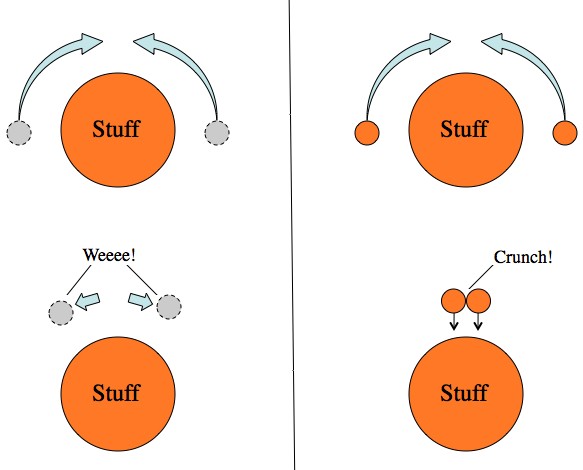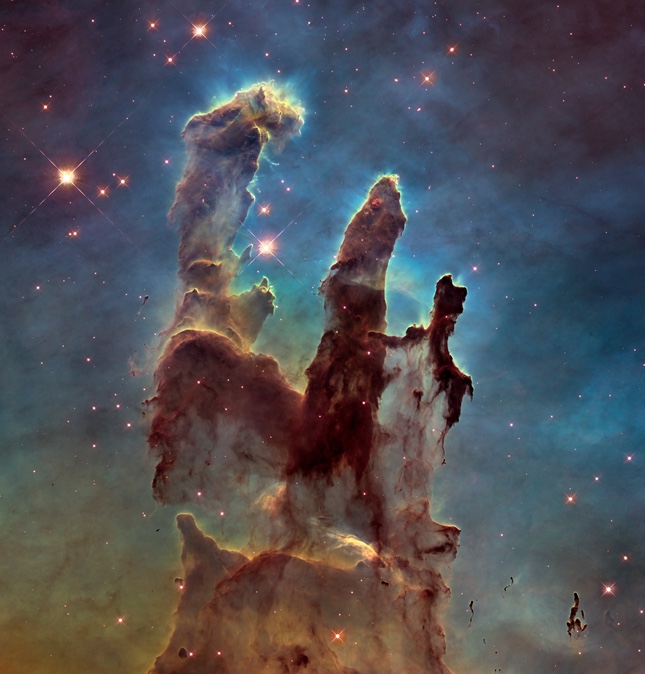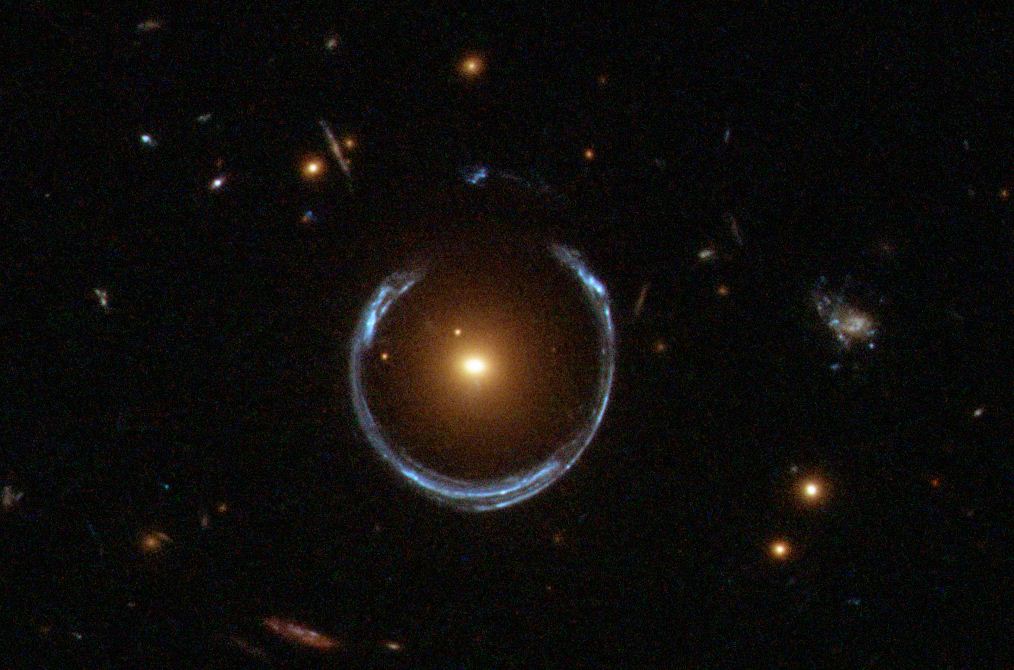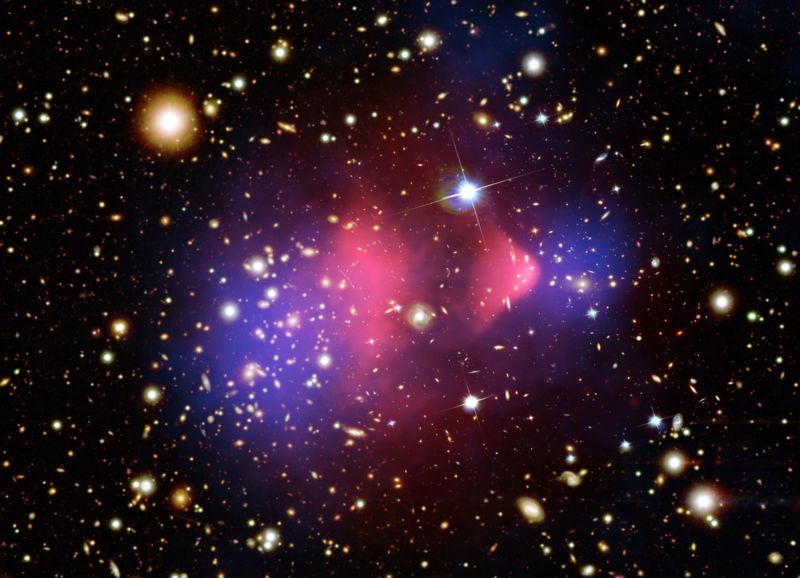Physicist: The very short answer is: nope. Well… almost certainly nope.
“Dark matter” is stuff that we can’t see or touch, but we know it exists because it affects the motion of regular matter, which we can see. Although there were vague hints that dark matter might be a thing going back about a century, it wasn’t until the 1970s that direct observations of the movements of stars in galaxies revealed the presence of too much matter. Way too much.
There’s so much more dark than regular matter in the universe, that its gravitational influence more or less dictates where the biggest concentrations of matter (galaxies and even galaxy clusters) end up.

By including dark matter in mathematical simulations, we get results that correspond well with the largest-scale distribution of matter in the universe, as well as the development of galaxies we see today.
One (possible) prediction of string theory is that our universe is a “brane“, a “sheet” of spacetime floating about in a higher dimensional space called the “bulk”. Other branes (other universes) might be floating around nearby, almost overlapping our universe, some small distance away. All of the particles native to a brane are stuck to it, but the gravity they produce might not be. So perhaps what we perceive as dark matter is really just the gravitation from matter in another nearby universe. That would explain why we don’t see it and why it doesn’t bump into things.

Artist’s interpretation of Brane Cosmology. Particles are stuck to branes (the sheets), which exist in a higher dimensional “bulk” spacetime (the back yard), but gravity from one brane can affect things in another. Maybe.
The danger of this line of thinking is that it requires taking several steps beyond the shelter of direct experimental evidence. The bulk, other branes, and even string theory itself are just a bunch of interesting ideas, since none of the theory’s novel predictions have been supported by experiment (so far).
Before delving into brane stuff, it’s worth considering what we know about dark matter. By carefully tallying up the number of stars, the distribution of their masses, the amount of gas and dust (by looking at how the local starlight filters through it), and then figuring out the amount of gravity due to all of it, we can figure out how fast each star in a galaxy should be orbiting said galaxy. We found two things: first, that there’s many times more matter in play than we can see and second, that this unseen matter is distributed around every large galaxy as though it had never been subject to accretion. That last bit is important.

Chunks of ordinary matter (orange) can bump into each other, causing them to slow down and concentrate in one place. Dark matter (grey) doesn’t bumping into anything, including itself, so it stays spread out.
Accretion is why stuff in space tends to clump together or flatten out into disks (or both!). When stuff has the option of bumping into itself, collections of matter go from incomprehensibly big, fluffy clouds, to concentrated pin-points (like stars and planets).

The four light-year tall Pillars of Creation form a tiny corner of the Eagle Nebula. This gas and dust is extremely spread out, but through accretion it concentrates a lot. If those pillars were each the size of Florida, the stars forming inside of them would be roughly the size of a piece of fruit.
By looking at the orbital speeds of stars vs. the distance to their galaxy’s cores we find that they are orbiting a disk of stuff as well as a diffuse cloud with around ten times the mass (the exact ratio varies from galaxy to galaxy). So whatever dark matter is, there’s lots of it and it doesn’t bump into anything.
The big difference between the 1970s and now is computer power, space telescopes, and the gradual muting of hairstyles. And nothing else. As our telescopes and computers improved slightly over the last few decades, we’ve been able to determine not just that dark matter exists, but where it exists and how much is around. Gravitational lensing bends light as it passes really heavy things. Determining the amount of mass in something based on how much it distorts the image of things behind it is something that’s very difficult to do with a slide ruler, but is pretty easy with a post-Pong-era computer.

A remarkable alignment of us (the camera), a galaxy (orange blurry thing), and a distant galaxy (smeared out blue ring). The gravity of the orange galaxy warps the image of the galaxy behind it.
If dark matter and regular matter show up in more or less the same place (which they usually do), then it’s difficult to tell the difference between the existence of dark matter and a misunderstanding of how gravity works. Luckily, dark matter is not only heavy but weakly interacting; a property that reveals itself when huge blobs of ordinary matter collide and their associated blobs of dark matter notably don’t.
The Bullet Cluster is actually a pair of colliding galaxy clusters. When galaxies or galaxy clusters collide their stars miss each other (because stars are stupid small compared to the distances between them), but their massive gas clouds find each other just fine. When they do, they heat up (not just from the physical impact but from being tossed around by their mutual magnetic fields) until they glow in the x-ray spectrum. Shining with x-rays makes these impacts stand out pretty clearly. So you’d expect that when galaxy clusters run into each other there should be a decent smearing of mass with a big chunk in the middle where the gas clouds pancake into each other. Instead, we see some hot gasses in the middle of the impact with the vast majority of the mass taking the form of two big chunks that cruised right through.

The Bullet Cluster is a collection of galaxies 3.7 billion light-years away (behind all the other galaxies and stars seen here). In this (very altered) picture the foreground galaxies are imaged in the visible spectrum (that’s actually what they look like), the pink blur is x-rays emitted by the colliding clouds of gas in the two clusters, and the purple is an overlayed map of matter density generated by analyzing gravitational lensing.
The point here is that dark matter is literal, actual stuff, not just a massively boneheaded mistake or miscalculation. You can point at where it is, say how much is there, and even talk about what it’s doing. We just can’t directly detect it because it doesn’t touch anything. As it turns out, that isn’t completely strange.
Different particles interact through different forces. For example, protons interact through all four fundamental forces: the strong nuclear force, the weak nuclear force, the electromagnetic force, and gravity. The strong force, keeps protons and neutrons packed tightly together in atomic nuclei. Electrons on the other hand interact through all but the strong force, which is why they buzz around the nucleus instead of being inside it.
Neutrinos only interact through the weak and gravitational forces. When you try and fail to walk through a wall, you’re interacting through the electromagnetic force. Without the electromagnetic force, neutrinos are free to pass right through damn near anything. On the order of a trillion pass through your body every second, and yet our best, biggest neutrino detectors only pick up a couple dozen a day (mostly from the Sun, and the detectors work both day and night since neutrinos don’t really notice the Earth). Since they interact through the weak force (and not very well) neutrinos are “weakly interacting”.
Whatever dark matter is, it seems to take things one step further: interacting through gravity alone. Without the strong force it wouldn’t form elements. Without the electromagnetic force it passes through ordinary matter and itself. And without the weak force we’re left with no way to directly detect it. But if there’s enough of it (and there seems to be), then we can detect its gravity.
Right now the search for dark matter is a little like setting out traps in your house because your cheese keeps going missing and you can hear skittering in the walls. There’s definitely something there and you know more or less where it is and what it’s like, but it would be nice to know exactly what you’re dealing with.
So to actually answer that question from way back when: could dark matter be the gravity of stuff in another universe (or brane or whatever) bleeding into ours? Probably not. Dark matter doesn’t interact with ordinary matter, which could be because it’s on a different brane. But even so, based on how it gets distributed we know that it doesn’t interact with itself either. So bringing extra universes into play doesn’t answer any questions, it just muddies up an existing question with untested ideas. It’s like using honey to get gum out of your hair; the situation is different, maybe even thought provoking, but not better.
The mathematical model of the universe picture is from here.
The “brane” picture is from here.
The space stuff is all from NASA.
The chewed up wire picture is from here.








Glad you admit it couldn’t be the shadow of multiple universes. But that isn’t to say you don’t believe in multiple universes, which you probably do. Dark Matter doesn’t exist, btw. It’s just a fudge factor to continue to uphold the absolute failure of the big-bang theory.
Basically, not enough brane power. 🙂
@ Tommy Scott
Kudos to you! Pleased to see there is another BB skeptic.
String theory has 7 extra dimension that has really no good explanation. It is assumed that they are compactified to such a small size that their influence cannot be measured. What if the six extra spatial dimensions are associated to two parallell universes/branes with open dimensions just as the physical universe? Dark matter could belong to one brane and dark energy to the other. We would have dark matter and dark energy all around us. I think this is a configuration worth exploring. The last dimension (the 11th dimension of string theory) called coupling strength, could be speed of time which equals scope of view, which introduces consciousness to the bulk/cosmos. I am surprised that string scientists are not interested in looking further into these alternatives. I cannot see any hindrance of including consciousness to the cosmos so far, but it might be considered a high professional risk for a physicist to really accept this as a area for research. More stuff on this including published articles can be found on amatterofmind.net
Keep up. String theory is a bust. Don’t you know about the bet that their proponents lost when the evidence was never found at CERN?
Tommy
Do you have any evidence that string theory is wrong? I could not find any, but I think string scientists have misinterpreted the extra dimensions. If you use the interpretation mentioned above, then even consciousness and mind can be included to the string theory. I think this could advance physics beyond the standard model. I think a problem with physics is that there is such a high number of strong believers based on pore evidence, – which is blocking curiosity and possibility to find new understanding.
Like I said, don’t you know about the failed bet where the evidence required to uphold string theory was not found at CERN?
No, consciousness and mind cannot be included in pseudo-scientific theories such as string theory. Consciousness and mind were created by God. The universe was created by God. You were created by God.
From Wikipedia “observations imply that the sum of the three masses must be less than one millionth that of the electron.”
According to this, we have observed maybe one electrons worth of nutreno mass (probably less), in 70 years of detection. what makes us believe that Nutrenos account for 10 times more mass than the observable mass in our universe?
Tommy
The the missing findings in Chernobyl were not required for string theory to be mainly correct, but if they were found they would strengthen string theory. I see no point in discussing beliefs.
I wish you all well in your chosen cosmos, but you miss a lot of interesting exploration.
@Jeff
Wishful thinking.
In order to detect something, a it needs to do something. So we don’t detect a neutrino’s mass, we detect their kinetic energy (on the rare occasions it smacks other particles around). But those neutrinos with a detectable amount of inetic energy are traveling at effectively the speed of light. Dark matter is “cold” by comparison; it’s moving about as fast as stars orbit (because it’s doing the same thing). If dark matter were made of neutrinos, we wouldn’t expect to be able to detect it (the kinetic energy of the neutrinos would individually be too small to do anything noticeable). Still leaves the question: where did it come from?
How do we know that dark matter doesn’t interact with the weak force? Or I guess, how do we know that neutrinos aren’t the dark matter particle?
Do the terms untested and untestable carry the same weight in science? Considering we are locked into the 3+1 dimensions of this universe, can any higher dimension or multiverse idea ever truely be tested? Anything that originated from those areas are effectively out of bounds to us aren’t they?
@Jeff
Definitely not! “Untestable” means “not science” whereas “untested” means “try harder”.
The three dimensions of regular space are big in the sense that you can literally move in any of the three directions (or any combination) as far as you like. The extra dimensions of string theory are (supposedly) very, very, very small and loop back on themselves. The classic example is an ant on a wire; to a person the wire appears one dimensional (back and forth) while to the ant there’s an extra dimension (side to side) that isn’t very big (go sideways on a wire and you’re back where you started pretty quick). By understanding the nature of how particles interact in this more complicated space we can make predictions about what we should see in the lab, and if we do, then those dimensions are more likely to exist.
That all said: it hasn’t panned out so far.
Wouldn’t that apply to any talk of a multiverse? Is there any way to prove a multiverse short of having a quark pop up with a multiverse stamp on its pass port? Yet scientists on the discovery networks talk about it With a sense of legitimacy.
Why doesn’t the gravity of dark matter hold particles together? Shouldn’t two particles moving slow enough with respect to each other hang together with gravity alone? Asked a slightly different way: Would ordinary matter accrete if particles passed through each other?
@Jeff
Would which part apply to any talk of a multiverse?
Keep in mind that physics isn’t about “proving” things, it’s about finding rules that work 100% of the time. Generally speaking, if you have a reason for predicting that rule is true, then your reason is likely to be true, but it may also be “accidentally” true for some other reason.
For example, Newton (and practically everyone else at the time) thought that light was a particle because it travels in straight lines. But it turns out that this straight-line-ness is also explained by the wave nature of light as well.
@Wayne
The force of gravity between individual particles is negligible compared to every other concern. The force of gravity between you and something the size of a comet is too small to keep you from literally jumping off. Individual particles in orbit around a galaxy are typically moving at dozens to hundreds of km per second relative to each other; the gravity between any pair does nothing to change that.
My whole line of questions started with this statement. “So bringing extra universes into play doesn’t answer any questions, it just muddies up an existing question with untested ideas”. Then “Definitely not! “Untestable” means “not science” whereas “untested” means “try harder”.
In the case of the photon, we know it exists because we can see. We know where it comes from because we can only see when the suns up or a light is on. Then it becomes a series of tests to learn how it behaves. Or take your absolute favorite name in all of science, Quantom Teleportation. It’s only because we affected one particle and observed its effect on the other that we can say quantom teleportation happened. If we were only on one side of that test, we couldn’t say it was anything more than a demonstration regular old superposition. In the case of the Brane bleeding gravity idea . We can observe the effect side of dark matter. But we’ll never observe the affect side being a gravity bleeding Brane.
So I guess what I’m wondering is, can any idea or theory involving a different universe, or even just the existence of another universe, ever really be tested?
@Jeff
I’m fairly sure the answer to that question is ‘maybe’ or ‘it’s too early to say.’
What if the different branes have different properties different from ours and different laws of physics?
Or even that they don’t bump into each other simply because there are many separate branes with matter?
Thank you first for giving us a chance to opine on these cool subjects!
Dark matter can’t be detected (or so far hasn’t). And virtual particles (being really a way to describe how the quantum field mediates interactions I think) can’t be observed, yet they have an effect.
Could it be dark matter is due to a wonky effect of virtual particle interaction calculations (Feynman diagrams) that mediate regular matter interactions, that hasn’t been noticed because equations have to be solved approximately (like with perturbation theory)?
I especially like that idea because dark matter is supposed to be really spread out in outer space, and outer space is very cold, and when things are very cold there’s a chance wave functions wouldn’t decohere as much, so maybe you could have some effect carrying outward a fair distance from clumps of matter that resembles matter in its effect on gravity but is just a spread out wave function. Then everytime we try to look at it we don’t see it because the wave function collapses into say an ordinary Galaxy from our point of view.
First, dark matter is pure hypothesis. In a court, it would be like very convincing circumstantial evidence, so complete that it works to convict. But science doesn’t progress very far that way. If it was, we’d still believe in ether. (Want to see a dark matter theorist get upset? Compare it to the 19th c. belief in ether, also a rock solid effort to explain contradictory facts with imaginary stuff).
Multiverses are also hypothesis. They have one difference. The alternative – a single universe – is also a hypothesis. We don’t know if what we see is the edge, the trace of a beginning, or not. Multiverses could overlap, in ways that could end up seeming run-of-the-mill. We’re might be watching one and not know it. Further, a multiverse simply extends the principle demonstrated over and over, that there’s no end. There’s no flat earth, we’re not the only galaxy.
Dark matter is a postulate, not an alternative. If it doesn’t exist, that doesn’t mean another kind of matter does instead. For that reason, the initial question is logical. If dark matter doesn’t exist, some other equally unexpected phenomena must.
Given Everett, given theories of inflation, it’s possible that a multiverse may intersect our universe. We don’t see them, presumably, or there wouldn’t be many missing starts. Electromagnetic radiation may have properties that limit it to single universes. If gravity isn’t so limited, then an intersecting multiverse could influence what we see, to produce the clumped objects we see.
To those who say these are untestable ideas, please admit one thing: they’re untestable so far, and so far as you can imagine. Scientific breakthroughs occur when someone sees further than before, not just an idea, but the manner in which it can be proven.
“based on how DM gets distributed we know that it doesn’t interact with itself either. So bringing extra universes into play doesn’t answer any questions”.
I totally not agree with this statement being applied here. It is a very weak argument because ordinary matter existing on the same brane (as our Universe) will interact with itself but will not interact directly with matter on other branes. This can explain why DM is having such distribution as we see leaking gravity from matter placed on multiple branes.
Matter existing on different branes can be bound gravitationally, thus forming 4D space structures like multi-dimensional galaxies. I think such concept explains asymmetric structures like Bullet Cluster much better then classical DM models (like Axions, WIMPs).
I woke up this morning, after some time in the twilight zone, and thought about, what if:
Dark matter is a part of a universe included in our and in a second universe? We are a part of the other universe, as well as they are a part of ours, we just cannot see them, and they can not see us.
We need matter to exist, atoms an so on, and energy from the sun. What if dark matter and dark energy, is just there? There could then exist 2 or more universes included in the same space, but not detectable universes in between? Because matter and energy is not the same in the other universes.
I belive in a live after death. Maybe it is to be, in the other universe, right within us.
Quantum mechanics say: nothing des apairs, all data will exist for ever. 🙂
@physicist
Great discussion. Dark matter having never been subject to accretion is a rather important observation. However, I’ve never heard this mentioned in a DM documentary even though most postulate that gravity from parallel Universes is a possible explanation. Seems like a rather egregious omission.
@Mark
It really is. Most popular science communication seems to be afraid that any math or details will scare away “non-scientists”.
Pingback: Dark Matter is Real. "Dark Matter" is a Terrible Name for It – Out There – Discover Magazine | Everyday News Update
Pingback: Dark Matter is Real. "Dark Matter" is a Terrible Name for It |
My follow-up question is: could dark matter be just a sort of dimensional shadow caused by higher dimension geometry itself?
So not actual mass on another brane, but instead just a topological effect of a higher dimension with energy in it that we see as dark matter in our three dimensional space?
So eg. a “higher dimension construct” is formed in a way that some sides/planes of it form our three dimensional universe, yet it’s just a portion of the construct itself.
Think a visualization of a hypercube. For us it seems like it “crunches” and folds on itself when we draw a 3D-visualization of it on a 2D plane like display.
= could these planes of the higher dimensional construct interacting with our three dimensional fragment of that same construct be what we see as dark matter? So not matter at all, but more of “a quasiparticle” of a topological shape?
Leading to the end question: Could dark matter behave like a quasiparticle does, but it’s caused by a higher dimensional construct folding/being in a dynamic state of change?
The normal way of definer higher dimensional universes is that each universe has more than three dimensions. My proposal, that matches observations and string theory, is that three universes with only three dimensions each form a complete cosmos. Big Bang was a splitting of particles (because of the expansion/cooling of the cosmos) from pure energy into three parallell universes that have different dimensions, altogether 9 such as required in string theory. These three universes make up the physical universe and the mind. In one universe we observe the thoughts, dreams, emotions etc. In the third universe which contains entities with simultaneous different values like quantum waves, we find the personality and the Self. Consciousness is connected to all three universes and is based on negative energy (has negative entropy). This give a balanced cosmos that can exist forever. Dark matter and dark energy are situated in these two different universes/branes that make up the mind, and influence physical matter such as measured. More detailed explanations and published articles on amatterofmind.net